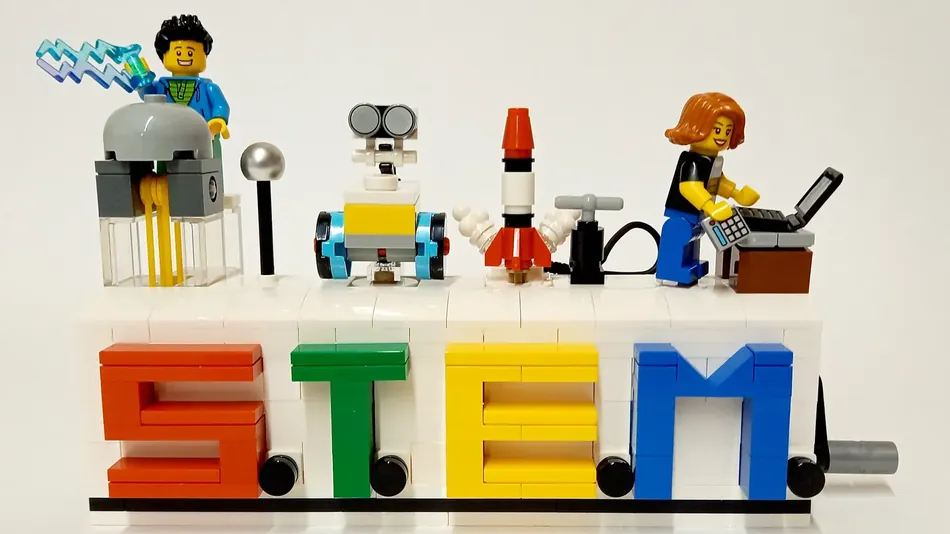STEM education has been a hot topic in recent years. Educators, governments, and CEOs of major companies encourage parents to get their children interested in STEM, even as babies. This has led to parents stressing if their children are playing with suitable toys. Take LEGO bricks: they’re lots of fun, but are LEGO STEM toys?
Yes! Yes! One thousand times YES! LEGO bricks are STEM toys. LEGO has many products that directly target specific STEM skills, such as programming and robotics, and even a bucket of random LEGO bricks is a STEM toy. The core skills of STEM are discovery and problem solving, exactly what playing with LEGO teaches a child.
STEM stands for Science, Technology, Engineering, and Math. Because of this, many parents think a STEM toy has to be labeled “technology” or “math” to be STEM. The root of STEM is often provided in foundational toys, such as the original LEGO building bricks. This doesn’t mean LEGO robotic kits are not wonderful; they are fabulous. But the basic LEGO bricks are often undervalued. It’s easy to take things too literally in our world these days, and this is true for the acronym behind STEM and what it represents. We know that STEM stands for four words: Science, Technology, Engineering, and Math. This has caused many to forget the plethora of key skills and components that make up the foundation of STEM.
STEM (science, technology, engineering and mathematics) comes to life for children through problem solving. These subject areas are interwoven in everyday life, and they serve as vehicles for the direct application of creativity and innovation skills. An overwhelming percentage of the most critical challenges facing this generation will require STEM knowledge coupled with keen creative problem-solving and collaboration skills. In nearly every modern-day business and education-based publication, there is mention of developing creativity and innovation skills. There is little disagreement that these skills are needed, but there is often a gap when it comes to implementing development opportunities for them. Many individuals find themselves wondering what tools they should tap into beyond brainstorming. While brainstorming is a key divergent thinking tool, there is the journey of strengthening and applying those ideas in context.
For Brick League we use the engineer design process. This process mirrors that of the Creative Problem Solving (CPS) process, which serves as a vehicle for moving through novelty and rises to challenges. By utilizing CPS throughout the invention process, children assess challenges, collect data through testing, generate solutions through trial and error, and continuously refine their ideas through evaluation and reflection. In applying this process to work through a real challenge, they can internalize it and refer to it later when they encounter a new challenge.
LEGO is a toy that sparks curiosity and inquiry. As a child (or a group of children) dig through a bucket of LEGO bricks and try to build, the toy encourages discovery, design, problem-solving, creativity, critical thinking, and invites collaboration. These are the key skills and components of STEM. In a traditional classroom setting, this natural inquisitiveness can often be overlooked in favor of good behavior and focus. Instead, shouldn’t we be focusing on igniting children’s interest in unfamiliar concepts?
While concern over the STEM skills shortage continues, it shouldn’t fall to schools to take a purely academic approach to shaping our future scientists, mathematicians and engineers. Could Einstein have discovered the theory of relativity without his persistent questioning of the world around him? Can children follow in the footsteps of those whose discoveries have shaped the world we know today when their academic performance, rather than their inquisitiveness, is their greatest asset? At a time when automation is becoming commonplace in the workplace, it’s our distinctly human traits that set us apart from the machines and will future-proof our careers for years to come.
To an extent, academic performance will always be measured in schools, but it’s a child’s approach to new and unfamiliar situations that will shape the next stage of their lives. Embracing alternative ways of teaching our children is an essential part of developing a child’s love of learning. When paired with their own curiosity, drive and perseverance, this is ultimately what will carry them through to the next stage of their education – and it will stay with them for the rest of their lives.

.png)